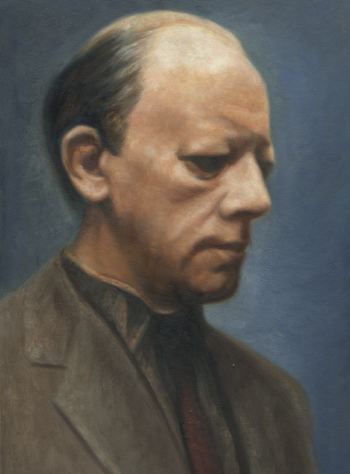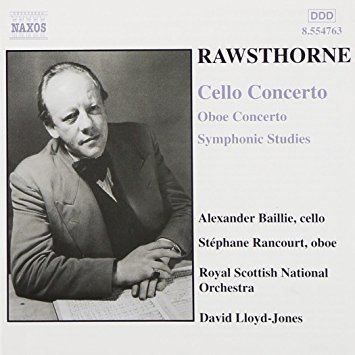Name Alan Rawsthorne Role Composer | Died July 24, 1971, Cambridge Siblings Barbara Rawsthome | |
 | ||
Parents Hubert Rawsthorne, Janet Bridge Compositions Practical Cats, Practical Cats, Practical Cats: Gus: The Theatre Cat (Allegro moderato), Practical Cats: Gus: The Theatre Cat (Allegro moderato), Practical Cats: Overture (Presto), Practical Cats: Overture (Presto), Concerto for Violin and Orchestra no 2: II Poco lento, Concerto for Violin and Orchestra no 2: II Poco lento, Concertante for Violin and Piano, Concertante for Violin and Piano, Fantasy Overture “Corteges”, Fantasy Overture “Corteges”, Symphony no 3: I Allegro, Symphony no 3: I Allegro, Quintet for Piano and Strings: I Allegro - Allegretto, Quintet for Piano and Strings: I Allegro - Allegretto, Sonata for Cello and Piano: I Adagio - Allegro appassionato, Sonata for Cello and Piano: I Adagio - Allegro appassionato, Symphony no 2 "A Pastoral Symphony": I Allegro piacevole, Symphony no 2 "A Pastoral Symphony": I Allegro piacevole, Symphony no 2 "A Pastoral Symphony": III Country Dance Allegro giocoso, Symphony no 2 "A Pastoral Symphony": III Country Dance Allegro giocoso, Quintet for Piano and Strings: III Lento non troppo, Quintet for Piano and Strings: III Lento non troppo, Trio for Piano - Violin and Cello: I Introduction: Poco lento - Capriccio: Allegro deciso, Trio for Piano - Violin and Cello: I Introduction: Poco lento - Capriccio: Allegro deciso, Practical Cats: The Old Gumbie Cat (Allegro), Practical Cats: The Old Gumbie Cat (Allegro), Concerto for Violin and Orchestra no 2: III Tema con variazioni, Concerto for Violin and Orchestra no 2: III Tema con variazioni, Sonata for Cello and Piano: II Adagio, Sonata for Cello and Piano: II Adagio, Symphony no 2 "A Pastoral Symphony": II Poco lento e liberamente, Symphony no 2 "A Pastoral Symphony": II Poco lento e liberamente, Symphony no 2 "A Pastoral Symphony": IV Andante, Symphony no 2 "A Pastoral Symphony": IV Andante, Quintet for Piano and Strings: IV Allegro, Quintet for Piano and Strings: IV Allegro, Concerto for Violin and Orchestra no 2: I Allegretto, Concerto for Violin and Orchestra no 2: I Allegretto, Symphony no 1: II Allegro, Symphony no 1: II Allegro, Sonata for Viola and Piano: IV Rondo: Allegro commodo, Sonata for Viola and Piano: IV Rondo: Allegro commodo, Symphony no 1: IV Poco maestoso - Allegro risoluto, Symphony no 1: IV Poco maestoso - Allegro risoluto, Quintet for Piano and Strings: II Allegro, Quintet for Piano and Strings: II Allegro, Symphony no 3: III Scherzo Allegro molto, Symphony no 3: III Scherzo Allegro molto, Practical Cats: The Naming of Cats (Allegretto), Practical Cats: The Naming of Cats (Allegretto), Concerto for Violin and Orchestra no 1: I Adagio espressivo e rubato - Andante con moto - poco teneramente, Concerto for Violin and Orchestra no 1: I Adagio espressivo e rubato - Andante con moto - poco teneramente, Symphony no 3: IV Allegro risoluto, Symphony no 3: IV Allegro risoluto, Symphony no 1: III Allegro non troppo, Symphony no 1: III Allegro non troppo, Concerto for Violin and Orchestra no 1: II Andante (I'istesso tempo) - Allegro - Allegro moderato, Concerto for Violin and Orchestra no 1: II Andante (I'istesso tempo) - Allegro - Allegro moderato, Sonata for Viola and Piano: III Adagio, Sonata for Viola and Piano: III Adagio, Sonata for Viola and Piano: I Maestoso - Molto allegro, Sonata for Viola and Piano: I Maestoso - Molto allegro, Practical Cats: The Song of the Jellicles (Molto vivace), Practical Cats: The Song of the Jellicles (Molto vivace), Practical Cats: Bustopher Jones: The Cat about Town (Andante pomposo), Practical Cats: Bustopher Jones: The Cat about Town (Andante pomposo), Practical Cats: Old Deuteronomy (Andante teneramente), Practical Cats: Old Deuteronomy (Andante teneramente), Sonata for Viola and Piano: II Scherzo, Sonata for Viola and Piano: II Scherzo, Trio for Piano - Violin and Cello: II Theme and Variations: Poco lento - Allegro - Allegretto, Trio for Piano - Violin and Cello: II Theme and Variations: Poco lento - Allegro - Allegretto, Symphony no 1: I Allegro tempestuoso, Symphony no 1: I Allegro tempestuoso, Sonata for Cello and Piano: III Allegro molto, Sonata for Cello and Piano: III Allegro molto, Symphony no 3: II Alla sarabanda Andantino, Symphony no 3: II Alla sarabanda Andantino Similar People Isabel Nicholas, Bohuslav Martinu, Charles Frend, Robert Donat, Basil Dearden | ||
Alan rawsthorne string quartet no 1 1939 alberni quartet
Alan Rawsthorne (2 May 1905 – 24 July 1971) was a British composer. He was born in Haslingden, Lancashire, and is buried in Thaxted churchyard in Essex.
Contents
- Alan rawsthorne string quartet no 1 1939 alberni quartet
- Alan rawsthorne elegy thomas hennell
- Early years
- Career
- Family
- Ballet
- Orchestral
- Concertante
- Chamber
- Instrumental
- Piano
- Vocal orchestral
- Choral
- Vocal
- References

Alan rawsthorne elegy thomas hennell
Early years

Alan Rawsthorne was born in Deardengate House, Haslingden, Lancashire (Anon. 2015a), to Hubert Rawsthorne (1868–1943), a well-off medical doctor, and his wife, Janet Bridge (1877/8–1927) (McCabe 2004). Despite what appears to have been a happy and affectionate family life with his parents and elder sister, Barbara (the only sibling), in beautiful Lancashire countryside, as a boy Rawsthorne suffered from fragile health (McCabe 2004; Green 1971). Although he did at various times attend schools in Southport, much of Rawsthorne's early education came through private tutoring at home (McCabe 2004). Despite a childhood aptitude for music and literature, Rawsthorne's parents tried to steer him away from his dreams of becoming a professional musician. As a result, he unsuccessfully tried to take on degree courses at Liverpool University, first in dentistry and then architecture. Concerning dentistry, Rawsthorne is on record as having said "I gave that up, thank God, before getting near anyone's mouth", while his friend, Constant Lambert, quipped "Mr Rawsthorne assures me that he has given up the practice of dentistry, even as a hobby" (Anon. 2006).
Career

In 1925, Rawsthorne was finally able to enrol at the Royal Manchester College of Music (Anon. 2015b), where his teachers included Frank Merrick for the piano and Carl Fuchs for the cello. In 1927, Rawsthorne's mother died aged just forty-nine. After graduating from the Royal Manchester College of Music around 1930, Rawsthorne spent the next couple of years pursuing his piano training with Egon Petri at Zakopane in Poland, and then briefly also in Berlin (McCabe 2004).
On his return to England in 1932, Rawsthorne took up a post as pianist and teacher at Dartington Hall in Devon, where he became composer-in-residence for the School of Dance and Mime (Belcher 1999a). In 1934, Rawsthorne left for London to try his fortune as a freelance composer. His first real public success arrived four years later with a performance of his Theme and Variations for Two Violins at the 1938 International Society for Contemporary Music (ISCM) Festival in London. The next year, his large scale Symphonic Studies for orchestral was performed in Warsaw, again at the ISCM Festival. The first in a line of completely assured orchestral scores, the Symphonic Studies, which can be heard as a concerto for orchestra in all but name, rapidly helped Rawsthorne establish himself as a composer possessing a highly distinctive musical voice (Evans 2001; Belcher 1999b).
Other acclaimed works by Rawsthorne include a viola sonata (1937), two piano concertos (1939, 1951), an oboe concerto (1947), two violin concertos (1948, 1956), a concerto for string orchestra (1949), and the Elegy for guitar (1971), a piece written for and completed by Julian Bream after the composer's death. Other works include a cello concerto, three acknowledged string quartets among other chamber works, and three symphonies.
Rawsthorne wrote a number of film scores. His best–known work in this field was the music for the 1953 British war film The Cruel Sea (Swynnoe 2002, 161), and his other scores included many popular British films, such as The Captive Heart (1946), School for Secrets (1946), Uncle Silas (1947), Saraband for Dead Lovers (1948), Pandora and the Flying Dutchman (1951), Where No Vultures Fly (1951), West of Zanzibar (1954), The Man Who Never Was (1956) and Floods of Fear (1958).
Family
Rawsthorne was married to Isabel Rawsthorne (née Isabel Nicholas), an artist and model well known in the Paris and Soho art scenes. Her contemporaries included André Derain, Alberto Giacometti, Pablo Picasso and Francis Bacon. Isabel Rawsthorne was the widow of composer Constant Lambert and stepmother to Kit Lambert, manager of the rock group the Who, who died in 1981. Isabel died in 1992. Alan Rawsthorne was her third husband; Sefton Delmer (the journalist and member of the Special Operations Executive during the Second World War) was her first husband. Isabel was Alan Rawsthorne's second wife, his first wife being Jessie Hinchliffe, a violinist in the Philharmonia Orchestra.
